Hallux rigidus, a form of degenerative arthritis that affects the big toe joint, can make wearing traditional women’s dress shoes incredibly painful. The condition limits toe flexibility and causes stiffness, swelling, and pain—especially when walking or wearing high heels with tight toe boxes. For women looking to maintain a polished appearance without sacrificing foot health, it becomes essential to find the best women’s dress shoes for hallux rigidus that combine support, stability, and style.
Fortunately, many modern footwear brands have developed orthopedic-friendly designs that accommodate limited toe mobility while still looking elegant. From structured soles that prevent excessive toe flexion to cushioned footbeds and rocker-bottom outsoles that reduce pressure, these shoes can significantly improve comfort for those living with hallux rigidus.
In this buying guide, we’ll explore exactly what features to prioritize, materials to look for, and styles that work best for this condition—so you can confidently select a pair of dress shoes that won’t compromise your foot function or fashion sense.
🛍 Buying Guide: How to Choose the Best Women’s Dress Shoes for Hallux Rigidus
1. ✅ Look for a Stiff Sole (Especially at the Forefoot)
Why it matters:
With hallux rigidus, the main issue is pain and stiffness in the big toe joint during toe-off (when the foot pushes off the ground). A stiff sole limits motion at the metatarsophalangeal (MTP) joint, reducing pain and further joint damage.
What to choose:
- Rocker-bottom soles that encourage forward motion without requiring toe flexion
- Firm midsole support with minimal bend at the forefoot
- Avoid flexible or minimalist soles that force your toes to bend
2. 👡 Choose Low or No Heel
Why it matters:
High heels force weight onto the front of the foot, increasing pressure on the big toe joint—exactly where hallux rigidus causes pain. Lower heels distribute weight more evenly and reduce strain.
Ideal heel height:
- Flat to 1.5 inches
- Block heels or wedges for added stability
- Avoid stilettos or narrow heels
3. 👣 Prioritize a Wide, Rounded Toe Box
Why it matters:
Tight or pointed dress shoes can further restrict toe movement and exacerbate pain. A wide toe box gives the big toe room to rest in a neutral position.
What to look for:
- Anatomical toe shapes
- Extra depth shoes
- Avoid narrow, pointed-toe styles
4. 🧵 Opt for Cushioned, Contoured Footbeds
Why it matters:
Footbeds with shock absorption and arch support reduce the overall stress on your feet. Hallux rigidus often changes your walking pattern, which can affect knees, hips, and back—so proper support is essential.
Recommended features:
- Memory foam or EVA cushioning
- Arch support (especially for flat feet)
- Removable footbeds for custom orthotics
5. 👟 Check for Firm Heel Counters and Midfoot Support
Why it matters:
Firm heel support keeps the foot aligned and stable during walking. This helps reduce compensatory movements that can stress the toe joint or cause pain in other areas.
Look for:
- Reinforced heel counters
- Molded footbeds with arch reinforcement
- Supportive outsoles with good traction
6. 🔄 Adjustability Is Key
Why it matters:
Shoes with adjustable straps, buckles, or elastic panels provide a better fit—especially if your feet swell or you wear orthotics. A secure, customized fit also reduces friction and instability.
Great options include:
- Velcro closures
- Buckled Mary Jane styles
- Elasticized gore inserts on loafers
7. 🧼 Breathable and Flexible Uppers Help
Why it matters:
Shoes that are breathable and slightly forgiving will reduce irritation over pressure points. Soft materials like leather or stretch fabric conform to the shape of the foot without squeezing it.
Preferred materials:
- Premium soft leather or suede
- Knit or mesh uppers for breathability
- Padded collars to prevent chafing
8. 🩺 Look for Podiatrist-Approved or Orthopedic Brands
Why it matters:
Shoes designed with medical insight often address the functional limitations caused by hallux rigidus. These brands often offer rocker soles, firm midsoles, and appropriate heel-to-toe drop.
What to expect from these brands:
- Certified orthotic compatibility
- Therapeutic design to relieve big toe stress
- Focus on joint stability and reduced pain during walking
9. 🧩 Don’t Forget Aesthetic Balance
Why it matters:
Style matters—especially in dress shoes. Thankfully, many orthopedic-friendly shoes now come in elegant styles including loafers, ballet flats, pumps, and wedges that won’t look overly medical or bulky.
Style tips:
- Choose solid colors (black, nude, navy) for versatile use
- Look for decorative straps, textures, or finishes to dress up the shoe
- Avoid shoes that are completely flat and unsupportive just for looks
10. 🛍 Try Shoes Late in the Day for Best Fit
Why it matters:
Feet tend to swell throughout the day, and trying on shoes when your feet are at their largest helps ensure you’ll get a comfortable fit. This is especially important for women managing arthritis or joint pain.
🧠 Summary: What to Prioritize in Dress Shoes for Hallux Rigidus
| Feature | Why It’s Important | What to Look For |
|---|---|---|
| Stiff Sole | Limits painful toe joint movement | Rocker-bottom, firm forefoot |
| Wide Toe Box | Reduces joint compression | Round or anatomical shape |
| Low Heel | Prevents added forefoot pressure | 0–1.5 inch, block or wedge heel |
| Cushioned Insole | Provides shock absorption and comfort | EVA foam, memory foam, arch support |
| Adjustability | Ensures proper fit and reduces irritation | Velcro straps, elastic panels, buckles |
| Breathable Upper | Keeps feet cool and reduces friction | Soft leather, mesh, stretchable materials |
| Orthotic Compatibility | Allows you to use custom support if needed | Removable footbed, deep interior |
Here are six top-rated women’s shoes that are especially suited for hallux rigidus, combining supportive design with dress-appropriate styling. Each model offers firm soles, roomy toe boxes, rocker features, and cushioned fit to reduce pressure on the big toe joint.
1. Alegria Women’s Paloma Flat
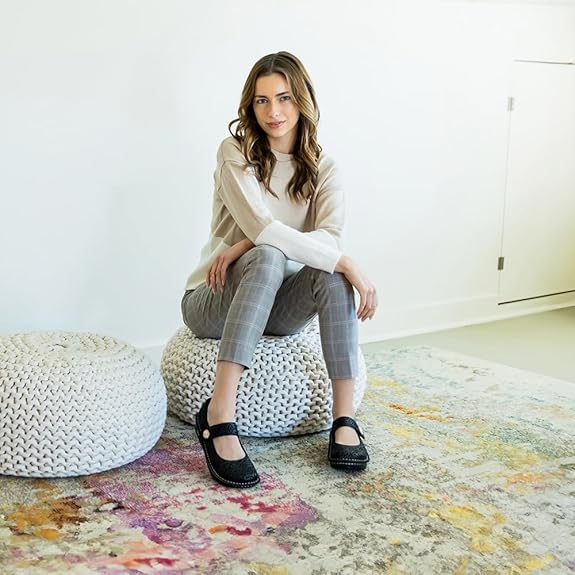
Check price on Amazon
Product Description:
The Alegria Paloma Flat features a wide toe box, soft leather upper, and a rocker-bottom outsole—all designed to reduce pressure on the stiff big-toe joint. The removable cork-latex footbed offers arch support and shock absorption, while the adjustable instep strap ensures a secure, comfortable fit.
Key Features:
- Rocker-bottom outsole limits toe motion
- Extra-wide toe box and adjustable strap
- Removable cork-latex footbed for arch support
- Full-grain leather upper, breathable lining
- Slip-resistant outsole
Pros:
- Excellent for limiting painful toe flex
- Roomy fit accommodates swelling
- Lightweight and cushioned for long wear
- Stylish enough for casual-to-semi-formal use
Cons:
- A bit casual for formal dress codes
- Reported squeakiness in some colors
Recommendation:
Perfect for hallux rigidus sufferers seeking a flat that’s both comfortable and supportive for daily wear
2. Dansko Women’s Walker (Rocker Sole Loafer)
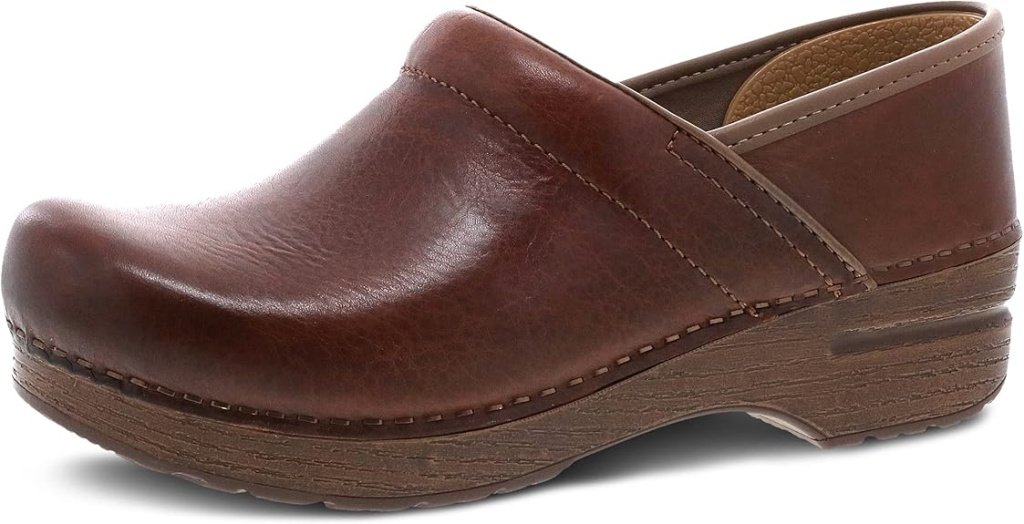
Check price on Amazon
Product Description:
The Dansko Walker is a professional-grade loafer with a firm rocker sole that reduces toe joint movement. It features a roomy round toe box, triple-density footbed with arch support, and a full-grain leather upper. Despite building orthotic-level support, it maintains a polished aesthetic suitable for work.
Key Features:
- Rigid rocker sole with PU outsole
- Roomy toe box and firm heel counter
- Removable triple-density footbed
- Full-grain leather upper
- Slip-resistant sole
Pros:
- Reduces pressure on the MTP joint
- Maintains professional appearance
- Firm heel & arch support
- Excellent stability and traction
Cons:
- Slightly stiff initially
- Not designed for very wide feet
Recommendation:
Ideal for office professionals with hallux rigidus needing reliable support in a dress shoe style.
3. Clarks Women’s Linvale Jerica Pump
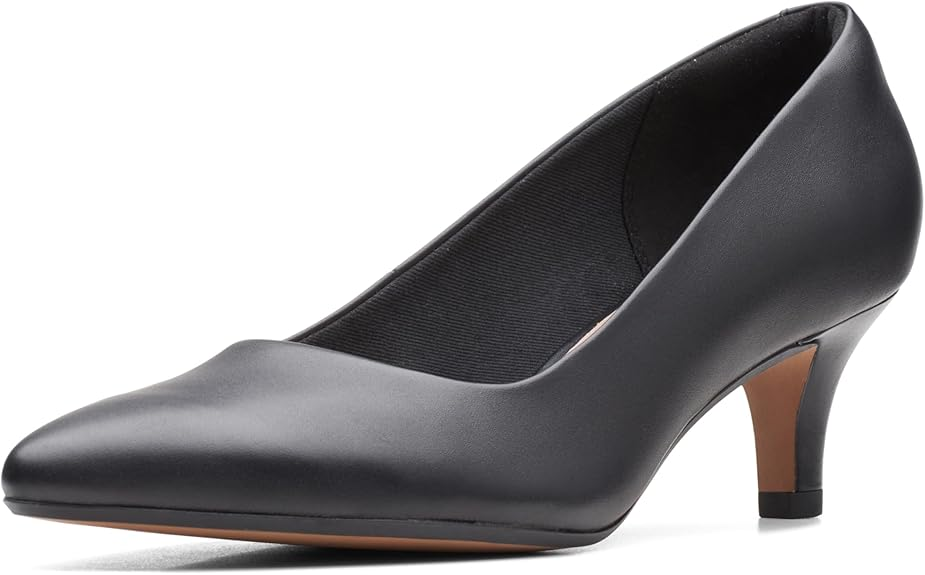
Check price on Amazon
Product Description:
Clarks’ Linvale Jerica combines Cushion Soft™ comfort padding with a moderately low heel and a shaped toe box that allows ample room in the forefoot. While lacking true rocker soles, its flexible yet supportive design helps reduce hallux joint irritation.
Key Features:
- Cushion Soft™ technology for shock absorption
- Moderate low heel (~1.75 in) with stable base
- Slightly wider toe-box than typical pumps
- Leather upper with smooth lining
Pros:
- Cushioned and soft interior
- Dressy enough for formal wear
- Helps reduce toe pressure through forefoot padding
Cons:
- Not a stiff or rocker sole
- May still flex slightly at the MTP joint
Recommendation:
A well-balanced option for those with mild hallux rigidus seeking dressy shoes with comfort padding .
4. Naturalizer Sienna Block Heel Pump
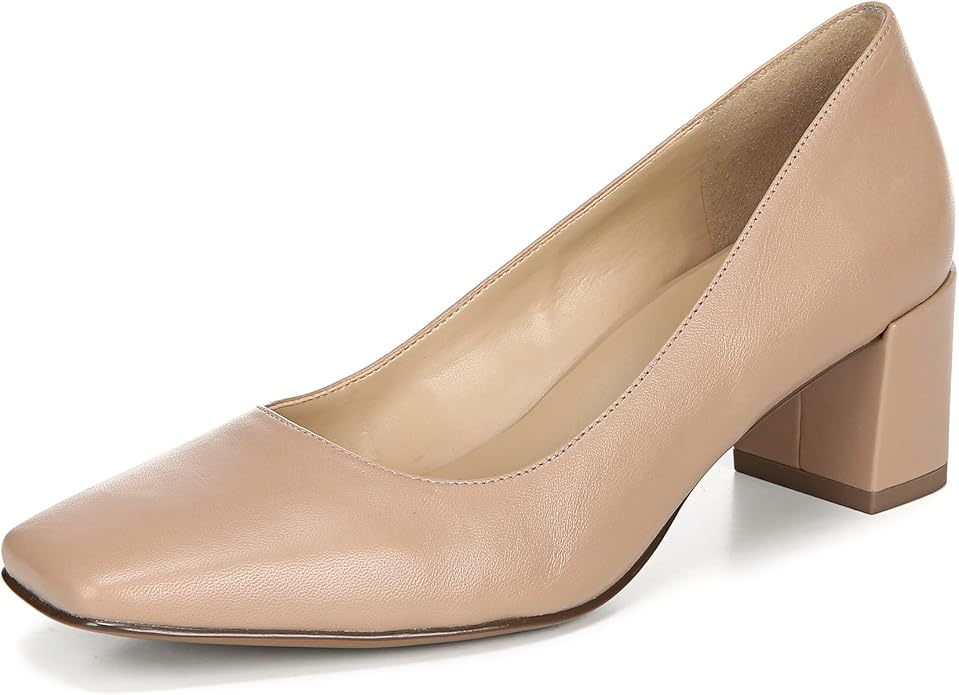
Check price on Amazon
Product Description:
The Naturalizer Sienna offers a moderately low block heel with a rounded toe box and cushioned insole. Ideal for professional dressers, it provides comfort features—like padded footbeds and soft linings—while limiting excessive toe bending thanks to its structured sole.
Key Features:
- Rounded toe with extra forefoot space
- Block heel (~1.5 in) for stability
- Cushioned insole and breathable lining
- Leather or suede upper options
Pros:
- Stylish and comfortably soft
- Provides mild restriction on toe flex
- Balanced heel height reduces pressure
Cons:
- Not a rocker–sole design
- Some users report narrow fit
Recommendation:
Great for women needing a dressy, supportive heel that doesn’t aggravate a stiff big toe.
5. Propet Women’s TravelActiv Fashion Sneaker
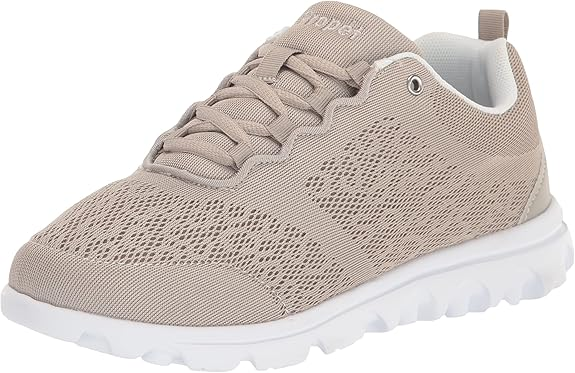
Check price on Amazon
Product Description:
Though technically a sneaker, the Propet TravelActiv blends walking-shoe tech with a sleek exterior suitable for business casual. It provides a firm EVA outsole with minimal flex, mesh/synthetic uppers for toe splay, and an Orthotic-friendly removable footbed—ideal for protecting a stiff toe joint.
Key Features:
- EVA sole with limited forefoot flex
- Removable cushioned footbed for custom orthotics
- Breathable mesh upper
- Hook-and-loop or lace closure options
Pros:
- Excellent traction and motion control
- Roomy fit allows toe to rest comfortably
- Proven comfort for hallux rigidus patients
Cons:
- Casual appearance—not formal
- Moderate arch support may need supplement for some
Recommendation:
Perfect substitute for dress shoes on walk-heavy workdays or event travel when style is more casual.
6. MBT Rani Dress Pump (Rocker Sole)
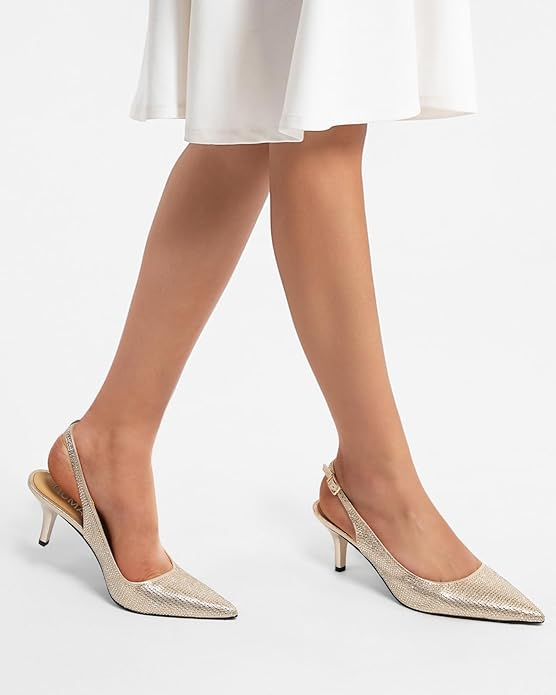
Check price on Amazon
Product Description:
MBT’s Rani is a dress-style pump with the brand’s signature MBT rocker sole, built to minimize bending at the forefoot. With a softly padded footbed and flexible leather upper, it’s designed to walk like a sneaker while appearing polished enough for dressy occasions.
Key Features:
- Mild rocker sole to reduce toe motion
- Firm midsole with arch contouring
- Leather upper with classic pump styling
- Low heel height but firm base
Pros:
- Minimizes strain on a rigid big toe
- Comfortable rocker rollout for walking
- Stylish enough for dressy wear
Cons:
- Bulkier sole than typical pumps
- More expensive than standard brands
Recommendation:
Elegant option for women with advanced hallux rigidus who need true rocker support in dressy footwear.
✅ Summary Table
| Shoe Model | Rocker Sole | Toe Box | Heel Height | Best For |
|---|---|---|---|---|
| Alegria Paloma Flat | ✔️ | Wide | Flat | Flat dress style with rocker relief |
| Dansko Walker Loafer | ✔️ | Wide | Low | Professional loafer with rigid sole support |
| Clarks Linvale Jerica | ✖️ | Medium | Moderate block | Dress pump with cushioned padding |
| Naturalizer Sienna | ✖️ | Moderate | Low block heel | Elegant yet supportive low heel pump |
| Propet TravelActiv | ✖️ | Wide | Flat sneaker heel | Comfortable walking style for hallux rigidus |
| MBT Rani Pump | ✔️ | Moderate | Low-moderate | Dress pump with full rocker sole benefits |
Certainly! Here’s a complete care and cleaning guide tailored to the types of shoes commonly recommended for women with hallux rigidus. Since these shoes often contain orthopedic features, special soles, or premium materials, proper maintenance is key to preserving both comfort and longevity.
🧼 How to Wash the Best Women’s Dress Shoes for Hallux Rigidus
1. 🥿 Leather Dress Shoes
How to Clean:
- Wipe regularly with a soft damp cloth to remove dust and surface dirt.
- Use leather cleaner for deeper cleaning. Apply a small amount to a clean cloth and rub gently in circular motions.
- Polish occasionally with a matching cream or wax polish to maintain shine and prevent cracking.
- Condition the leather every few months with a quality leather conditioner to keep it supple.
Caution:
- Never submerge leather shoes in water.
- Do not dry them near direct heat sources like radiators or sunlight—this can dry out and warp the leather.
- Avoid alcohol-based cleaners that can strip protective finishes.
2. 👟 Mesh or Knit Fabric Shoes (e.g., Propet TravelActiv)
How to Clean:
- Remove insoles and laces before cleaning.
- Spot clean with mild soap and a soft brush or sponge. Use warm water but avoid soaking the entire shoe.
- Allow to air dry naturally; stuff with newspaper or use a shoe tree to retain shape.
Caution:
- Do not machine wash unless the label explicitly says it’s machine washable.
- Avoid bleach or harsh detergents.
- Never put them in the dryer.
3. 👠 Synthetic or Faux Leather Shoes
How to Clean:
- Wipe down with a damp cloth and gentle soap solution.
- Dry with a soft cloth.
- Use a vinyl or synthetic shoe cleaner occasionally to remove scuffs.
Caution:
- Avoid using natural leather conditioners—they may damage synthetic material.
- Prolonged exposure to water can cause peeling or cracking.
4. 🩰 Suede or Nubuck
How to Clean:
- Use a suede brush to gently remove dirt and revive the nap.
- For stains, gently rub with a suede eraser or apply a bit of white vinegar on a cloth and blot the area.
- Always brush in one direction to maintain the uniform texture.
Caution:
- Never use water directly on suede—it may stain or warp.
- Do not apply polish or conditioner meant for smooth leather.
5. 🧼 Caring for Removable Insoles and Orthotics
How to Clean:
- Remove insoles regularly and wipe them with a damp cloth and mild soap.
- Let them air out overnight to prevent odor and moisture buildup.
- Use baking soda occasionally to neutralize odor.
Caution:
- Never put insoles in the washer or dryer.
- Don’t reinstall insoles until they are completely dry.
6. 📦 Storage Tips for Orthopedic Dress Shoes
- Store in a cool, dry place to prevent mildew or sole deterioration.
- Use shoe trees to maintain shape and absorb moisture.
- If storing long term, keep shoes in breathable fabric bags, not plastic.
🔍 General Cautions for Washing and Caring for Hallux Rigidus Footwear
| Issue | What to Avoid | Why It Matters |
|---|---|---|
| Soaking the shoes | Avoid full immersion | Weakens glue, warps structure |
| Using heat to dry shoes | Avoid radiators, dryers, direct sunlight | Can shrink, harden or deform materials |
| Harsh cleaners | No bleach or alcohol-based products | May damage orthopedic or comfort features |
| Over-scrubbing | Use gentle pressure | Can wear down protective coatings or mesh |
| Ignoring manufacturer labels | Always check interior tags | Cleaning methods vary per material & model |
✅ Frequently Asked Questions (FAQs)
1. What is hallux rigidus and how does it affect shoe choice?
Hallux rigidus is a form of arthritis that causes stiffness and pain in the big toe joint. It limits the toe’s ability to bend, making it essential to choose shoes that don’t force toe movement. Shoes with stiff soles, wide toe boxes, and rocker bottoms are ideal for reducing pain and accommodating the condition.
2. Can I wear heels if I have hallux rigidus?
Yes—but only low, stable heels. Shoes with heels higher than 1.5 inches often put too much pressure on the big toe joint, worsening symptoms. Block heels or wedge heels offer more stability and reduce strain on the toe.
3. What type of sole is best for hallux rigidus?
A rigid or rocker-bottom sole is best. These soles reduce the need for the big toe to flex while walking, helping minimize pain and prevent further joint damage.
4. Should I use orthotics in dress shoes?
Absolutely. If your shoes have removable insoles, you can insert custom or over-the-counter orthotics that provide additional arch support and reduce load on the big toe joint. Always look for dress shoes with removable footbeds if you plan to use orthotics.
5. Is there a difference between hallux rigidus and hallux limitus when selecting shoes?
Yes. Hallux limitus is an earlier, less severe stage of the condition where some motion in the big toe joint remains. Those with hallux limitus may tolerate slightly more flexible shoes, while hallux rigidus patients need stiffer, more supportive footwear.
6. Are any dress shoes both stylish and supportive for hallux rigidus?
Yes. Many brands now offer orthopedic-friendly dress shoes with hidden comfort features like padded footbeds, rocker soles, and wide toe boxes in sleek, elegant designs. Brands like Alegria, Dansko, and Naturalizer strike a good balance between style and support.
7. How often should I replace shoes if I have hallux rigidus?
Supportive shoes should be replaced every 6–12 months depending on usage. Worn-out soles or compressed cushioning can stop providing proper support and lead to increased pain or progression of the condition.
🏁 Conclusion
Living with hallux rigidus doesn’t mean giving up stylish or professional footwear. The right pair of women’s dress shoes for hallux rigidus can significantly reduce discomfort, protect the big toe joint, and help you maintain mobility throughout your day.
The best choices focus on:
- Rocker soles to reduce joint flex
- Wide toe boxes to prevent compression
- Low stable heels to balance posture
- Arch support and cushioning to improve comfort
With growing awareness around foot health, more brands are designing elegant, supportive dress shoes tailored to medical needs. Investing in the right footwear not only protects your joints but also enhances your confidence and daily quality of life.
